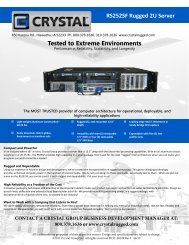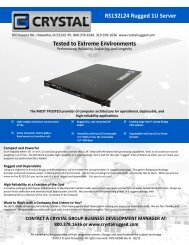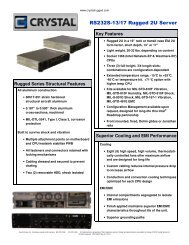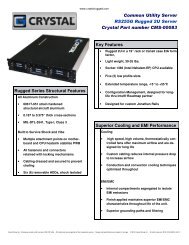Download our Current Deployments brochure [PDF] - Crystal Group
Download our Current Deployments brochure [PDF] - Crystal Group
Download our Current Deployments brochure [PDF] - Crystal Group
You also want an ePaper? Increase the reach of your titles
YUMPU automatically turns print PDFs into web optimized ePapers that Google loves.
<strong>Current</strong> <strong>Deployments</strong><br />
Marines<br />
JECCS<br />
JECCS - Joint Enhanced Core Communications System - is a telecommunications<br />
system that allows deployed military personnel to establish voice, video and data<br />
network connectivity. JECCS provides telecommunication services, Local Area<br />
Network (SIPRNET and NIPRNET) and network management services, messaging<br />
services, INMARSAT and UHF-TACSAT capabilities. The system is designed to<br />
interface with SATCOM (T1 and T3) that extends its services over the horizon and<br />
provides reach back capabilities. It supports the seamless transition from a small<br />
force's command and control element to that of a larger force. The transition to<br />
larger telecommunications systems such as the Digital Technical Control (DTC),<br />
and the Tactical Data Network (TDN) are fully supported by JECCS. The JECCS<br />
is housed in a S788 shelter that is mounted in a M1097 Heavy High Mobility Multi-Wheeled Vehicle (HMMWV). Within this<br />
vehicle, <strong>Crystal</strong>'s CIS100X mobile network server is used to maintain reliable Net Centric data connectivity. The <strong>Crystal</strong><br />
CIS100X hardware was chosen in conjunction with <strong>Crystal</strong>'s integration capability to provide a total solution package for the<br />
Marine JECCS program.<br />
NASA<br />
WAVE<br />
WAVE (WB-57 Ascent Video Experiment) is an important safety aspect of NASA's<br />
Return to Flight program. WAVE provides high-resolution, high-speed, on-board<br />
video imaging data of the Space Shuttle during launch and landing operations. The<br />
imaging equipment is carried in the nosecones of NASA's WB-57 jets. The WB-57s<br />
operate at altitudes higher than 60,000 feet on missions as long as 6.5 h<strong>our</strong>s over<br />
2,500 miles at speeds as fast as 410 knots. WAVE uses <strong>Crystal</strong> <strong>Group</strong>'s CS500<br />
servers to capture detailed images of the Space Shuttle as it climbs toward orbit.<br />
The CS500 <strong>Crystal</strong> server is tested to MIL-STDs 810F and 167-1, indicating that it<br />
meets the requirements for altitude, humidity, shock and vibration as well as extended operational temperature ranges.<br />
SVG<br />
The Space Video Gateway (SVG) system uses live and recorded downlink<br />
capabilities to deliver High Definition (HD) and Standard Definition (SD) video<br />
streams from the International Space Station (ISS) to the Johnson Space Center.<br />
Footage transmitted from the ISS includes research information, educational<br />
footage, external and internal equipment inspection data, and communications<br />
from the crew. SVG uses <strong>Crystal</strong>'s CS900 server on the Space Station to receive<br />
HD and SD video from on-board cameras and downlink the video streams using a<br />
NASA-developed network card. The CS900 server is tested to MIL-STDs 810F &<br />
167-1 and MIL-S-901D, meeting the requirements necessary for a space based operational environment.


![Download our Current Deployments brochure [PDF] - Crystal Group](https://img.yumpu.com/39975960/4/500x640/download-our-current-deployments-brochure-pdf-crystal-group.jpg)













